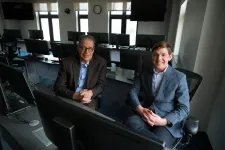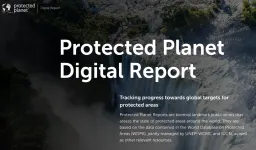For manufacturers, 3D printing, or additive manufacturing, provides a means of building complex-shaped parts that are more durable, lighter and more environmentally friendly than those made through traditional methods. The industry is burgeoning, with some predicting it to double in size every three years, but growth often goes hand in hand with growing pains.
Residual stress, a byproduct of the repeated heating and cooling inherent to metal printing processes, can introduce defects into parts and, in some cases, damage printers. To better understand how residual stress forms, and how it might be curbed, researchers at the National Institute of Standards and Technology (NIST), Lawrence Livermore National Laboratory, Los Alamos National Laboratory and other institutions closely examined the effects of different printing patterns in titanium alloy parts made with a common laser-based method.
Their results, published in Additive Manufacturing, show that a printing pattern often used in industry to decrease residual stress, known as island scanning, had the worst showing among the approaches studied, defying the team's expectations. The data they produced could help manufacturers test and improve predictive models for 3D printing, which, if accurate, could steer them away from destructive levels of residual stress.
"This was very surprising and underscores the complexity of the problem," said NIST materials research engineer Thien Phan, a co-author of the study. "It shows that, although island scanning may work in many cases, it did not work in ours, which really highlights the fact that we need to have accurate modeling."
The team's research centered on a prevalent additive manufacturing method called laser powder bed fusion (LPBF), in which a laser scans over a layer of metal powder in a predetermined pattern, melting and fusing particles at the surface together. As the molten metal cools into a solid, a stage supporting the material lowers and the printer adds a new coat of powder on top, allowing the laser to continue building the part layer by layer.
Once the second layer of a build begins, residual stress starts to rear its unpleasant head. The metals used in LPBF cool off quickly, meaning that by the time a printer's laser begins heating up a new layer, the metal from the previous layer is already solid. The melted layers contract inward as they cool, pulling on the solid metal below and creating stress. And the greater the difference in temperature, the more the melted layer pulls. This process repeats for every layer until the part is complete, locking the stresses into solid metal.
"You end up with an incredible amount of residual stresses inside your piece," said Phan. "So it's sitting there, tearing itself apart. The residual stress could crack the part and lift it up during the build, which could actually crash the machine."
The most straightforward printing pattern in LPBF is a continuous scan, where the laser scans back and forth from one end of the part to the other. But an alternative option called island scanning has emerged as a way to mitigate stress. The idea behind this approach is that melting small sections, or islands, of metal one at a time rather than an entire layer would result in less metal contracting at the same time, reducing the overall stress.
Island scanning has gained traction with manufacturers, but past studies on the technique have been inconsistent. And more broadly, the relationship between scanning strategies and residual stress largely remains a mystery. To begin filling in these gaps, the multi-institution team set out to analyze the effects of island scanning on stress in great detail.
The authors of the new study printed four titanium alloy bridges just over 2 centimeters (0.8 inches) in length. The samples were built via either continuous or island scanning, with lasers running along their length and width or at a 45-degree angle.
At a glance, the bridges looked similar coming out of the printer, but rather than take them at face value, the researchers scrutinized them in close detail.
They beamed high-energy X-rays, generated by a powerful tool called a synchrotron, deep into the samples. By measuring the wavelengths of X-rays that reflected off of the metal, the team extracted the distances between the metal atoms with high accuracy. From there the researchers calculated stress. The greater the distances, the more stressed the metal was. With that critical information in hand, they generated maps showing the location and degree of stress throughout the samples.
All samples contained stresses close to the titanium alloy's yield strength -- the point at which a material undergoes permanent deformation. But the maps revealed something else that caught the researchers by surprise.
"The island scan samples have these really large stresses on their sides and tops, which are missing or much less pronounced in the continuous scan samples," said NIST physicist and co-author Lyle Levine. "If island scanning is a way that industry is trying to mitigate these stresses, I would say, for this particular case, it is far from successful."
In another test, they detached a leg of each bridge from the metal base plates it was stuck to. The study's authors measured the distance the legs sprung upward, obtaining another indicator for how much residual stress was stored inside of the arch of each bridge. Again, the island scan samples performed poorly, their legs deflecting by more than twice as much as the other samples.
The authors propose that island scanning could be a double-edged sword. Although the small size of the islands may reduce contraction, the islands might also cool much faster than the larger melt pools, creating greater temperature differences and thus greater stress.
Although island scanning was not well suited to the particular part, material and equipment used in the study, it could still be a good choice under different circumstances, Phan said. The results do indicate it is not a cure-all for residual stress, however. To keep stress at bay, manufacturers may need to tailor the scanning strategy and other parameters to their specific build -- an effort that would be greatly aided by computer models.
Rather than optimize a print through trial and error, manufacturers could use models to quickly and cheaply identify the best parameters, if their predictions are accurate. Modelers could boost confidence in their tools by testing them against rigorously produced benchmark measurements, not unlike the data obtained in the new study, Levine said.
This work provides a new perspective on a popular printing strategy, adding a key piece to the puzzle of residual stress formation and ultimately bringing 3D printing a step closer to its full potential.
INFORMATION:

